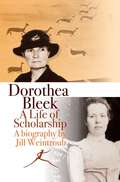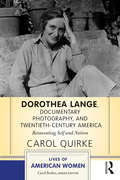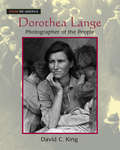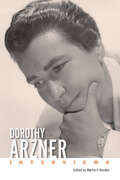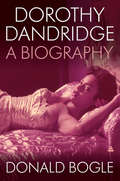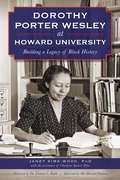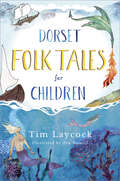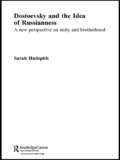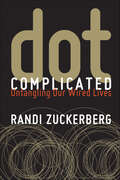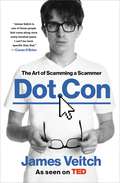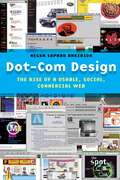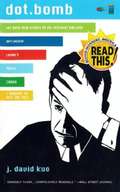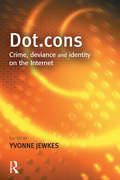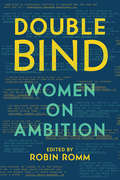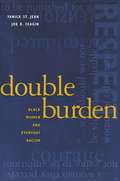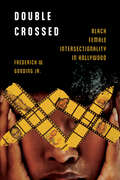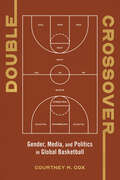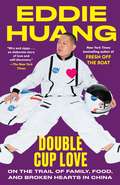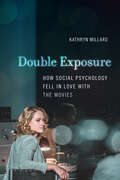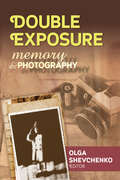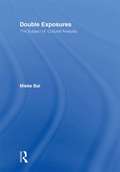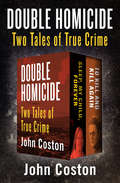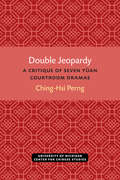- Table View
- List View
Dorothea Bleek: A life of scholarship
by Jill WeintroubDorothea Bleek (1873–1948) devoted her life to completing the ‘bushman researches’ that her father and aunt had begun in the closing decades of the nineteenth century. This research was partly a labour of familial loyalty to Wilhelm, the acclaimed linguist and language scholar of nineteenth-century Germany and later of the Cape Colony, and to Lucy Lloyd, a self-taught linguist and scholar of bushman languages and folklore; but it was also an expression of Dorothea’s commitment to a particular kind of scholarship and an intellectual milieu that saw her spending her entire adult life in the study of the people she called‘bushmen’.How has history treated Dorothea Bleek? Has she been recognised as a scholar in her own right, or as someone who merely followed in the footsteps of her famous father and aunt? Was she an adventurer, a woman who travelled across southern Africa driven by intellectual curiosity to learn all she could about the bushmen? Or was she conservative, a researcher who belittled the people she studied and dismissed them as lazy and improvident?These are some of the questions with which Jill Weintroub starts her thoughtful biography of Dorothea Bleek. The book examines Dorothea Bleek’s life story and family legacy, her rock art research and her fieldwork in southern Africa, and, in light of these, evaluates her scholarship and contribution to the history of ideas in South Africa. The compelling and surprising narrative reveals an intellectual inheritance intertwined with the story of a woman’s life, and argues that Dorothea’s life work – her study of the bushmen – was also a sometimes surprising emotional quest.
Dorothea Lange, Documentary Photography, and Twentieth-Century America: Reinventing Self and Nation (Lives of American Women)
by Carol QuirkeDorothea Lange, Documentary Photography, and Twentieth-Century America charts the life of Dorothea Lange (1895–1965), whose life was radically altered by the Depression, and whose photography helped transform the nation. The book begins with her childhood in immigrant, metropolitan New York, shifting to her young adulthood as a New Woman who apprenticed herself to Manhattan’s top photographers, then established a career as portraitist to San Francisco’s elite. When the Great Depression shook America’s economy, Lange was profoundly affected. Leaving her studio, Lange confronted citizens’ anguish with her camera, documenting their economic and social plight. This move propelled her to international renown. This biography synthesizes recent New Deal scholarship and photographic history and probes the unique regional histories of the Pacific West, the Plains, and the South. Lange’s life illuminates critical transformations in the U.S., specifically women’s evolving social roles and the state’s growing capacity to support vulnerable citizens. The author utilizes the concept of "care work," the devalued nurturing of others, often considered women’s work, to analyze Lange’s photography and reassert its power to provoke social change. Lange’s portrayal of the Depression’s ravages is enmeshed in a deeply political project still debated today, of the nature of governmental responsibility toward citizens’ basic needs. Students and the general reader will find this a powerful and insightful introduction to Dorothea Lange, her work, and legacy. Dorothea Lange, Documentary Photography, and Twentieth-Century America makes a compelling case for the continuing political and social significance of Lange’s work, as she recorded persistent injustices such as poverty, labor exploitation, racism, and environmental degradation.
Dorothea Lange: Photographer of the People
by David C KingA scholarly work that aims to be both broad enough in scope to satisfy upper-division undergraduates studying folk belief and narrative and detailed enough to meet the needs of graduate students in the field.
Dorothy Arzner: Interviews (Conversations with Filmmakers Series)
by Martin F. NordenThrough dozens of interviews, a detailed chronology and filmography, and a selection of Dorothy Arzner’s own writings—including her unfinished autobiography—Dorothy Arzner: Interviews offers major insights into and an in-depth examination of the life and career of one of the few women to direct films during Hollywood’s Golden Age. A key figure in Hollywood for decades, she directed more studio films than any other woman in history. Her movies often focused on courageous women who must make difficult decisions to remain true to themselves—women not unlike Arzner herself, who once said that “all we can ever do in our work is write our own biography.”Dorothy Arzner (1897–1979) began her film career in 1919 as a script typist for the Famous Players-Lasky company, which later became Paramount Pictures. She quickly rose through the ranks to become a script supervisor, screenwriter, and editor before directing her first film, Fashions for Women, in 1927. After the release of her final Hollywood film, First Comes Courage, in 1943, Arzner changed directions in her professional life. She made several training films for the Women’s Army Auxiliary Corps during World War II and directed many television commercials for Pepsi-Cola in the 1950s. She concluded her career by serving as a filmmaking instructor at the Pasadena Playhouse College of Theatre Arts and UCLA, where she helped launch the first wave of college-trained moviemakers.
Dorothy Dandridge: A Biography
by Donald BogleAvailable once again, the definitive biography of the pioneering Black performer—the first nominated for a Best Actress Academy Award—who broke new ground in Hollywood and helped transform American society in the years before Civil Rights movement—a remarkable woman of her time who also transcended it. “An ambitious, rigorously researched account of the long-ignored film star and chanteuse. . . . Bogle has fashioned a resonant history of a bygone era in Hollywood and passionately documented the contribution of one of its most dazzling and complex performers."—New York Times Book ReviewIn the segregated world of 1950s America, few celebrities were as talented, beautiful, glamorous, and ultimately influential as Dorothy Dandridge. Universally admired, she was Hollywood's first full-fledged Black movie star. Film historian Donald Bogle offers a panoramic portrait of Dorothy Dandridge’s extraordinary and ultimately tragic life and career, from her early years as a child performer in Cleveland, to her rise as a nightclub headliner and movie star, to her heartbreaking death at 42. Bogle reveals how this exceptionally talented and intensely ambitious entertainer broke down racial barriers by integrating some of America's hottest nightclubs and broke through Tinseltown’s glass ceiling. Along with her smash appearances at venues such as Harlem’s famed Cotton Club, Dorothy starred in numerous films, making history with her role in Otto Preminger’s Carmen Jones, playing opposite Harry Belafonte. Her performance earned her an Academy Award nomination for Best Actress—the first Oscar nod for a woman of color.But Dorothy’s wealth, fame, and success masked a reality fraught with contradiction and illusion. Struggling to find good roles professionally, uncomfortable with her image as a sex goddess, coping with the aftermath of two unhappy marriages and a string of unfulfilling affairs, and overwhelmed with guilt for her disabled daughter, Dorothy found herself emotionally and financially bankrupt—despair that ended in her untimely death.Woven from extensive research and unique interviews, as magnetic as the woman at its heart, Dorothy Dandridge captures this dazzling entertainer in all her complexity: her strength and vulnerability, her joy and her pain, her trials and her triumphs.
Dorothy Porter Wesley at Howard University: Building a Legacy of Black History (American Heritage)
by Charlynn Spencer Pyne Janet Sims-Woods Mr Howard Dodson Dr Thomas BattleWhen Dorothy Burnett joined the library staff at Howard University in 1928, she was given a mandate to administer a library of Negro life and history. The school purchased the Arthur B. Spingarn Collection in 1946, along with other collections, and Burnett, who would later become Dorothy Porter Wesley, helped create a world-class archive known as the Moorland-Spingarn Research Center and cemented her place as an immensely important figure in the preservation of African American history. Wesley's zeal for unearthing materials related to African American history earned her the name of "Shopping Bag Lady." Join author, historian and former Howard University librarian Janet Sims-Wood as she charts the award-winning and distinguished career of an iconic archivist.
Dorset Folk Tales for Children
by Tim Laycock Zoe BarnishDorset is full of mythical creatures from Britain’s most legendary folk tales, including demons, dragons, Jack-o’-lanterns, giants and mermaids. Read on to bring the landscape of the country’s rolling hills and Jurassic coast alive, and let author Tim Laycock inspire you to rediscover the county you thought you knew.
Dostoevsky and The Idea of Russianness: A New Perspective on Unity and Brotherhood (BASEES/Routledge Series on Russian and East European Studies #Vol. 6)
by Sarah HudspithThis book examines Dostoevsky's interest in, and engagement with, "Slavophilism" - a Russian mid-nineteenth century movement of conservative nationalist thought. It explores Dostoevsky's views, as expressed in both his non-fiction and fiction, on the religious, spiritual and moral ideas which he considered to be innately Russian. It concludes that Dostoevsky is an important successor to the Slavophiles, in that he developed their ideas in a more coherent fashion, broadening their moral and spiritual concerns into a more universal message about the true worth of Russia and her people.
Dot Complicated: Untangling Our Wired Lives
by Randi ZuckerbergWith Dot Complicated: Untangling Our Wired Lives, new media pioneer Randi Zuckerberg offers an entertaining and essential guide to understanding how technology and social media influence and inform our lives online and off.Zuckerberg has been on the frontline of the social media movement since Facebook’s early days and her following six years as a marketing executive for the company. Her part memoir, part how-to manual addresses issues of privacy, online presence, networking, etiquette, and the future of social change.
Dot Con: The Art of Scamming a Scammer
by James VeitchFrom viral comedy sensation James Veitch (as seen on TED, Conan, and The Tonight Show with Jimmy Fallon) comes a collection of laugh-out-loud funny exchanges with email scammers.The Nigerian prince eager to fork over his inheritance, the family friend stranded unexpectedly in Norway, the lonely Russian beauty looking for love . . . they spam our inboxes with their hapless pleas for help, money, and your social security number. In Dot Con, Veitch finally answers the question: what would happen if you replied?Suspicious emails pop up in our inboxes and our first instinct is to delete unopened. But what if you responded to the deposed princess begging for money in your Gmail? Veitch dives into the underbelly of our absurd email scam culture, playing the scammers at their own game, and these are the surprising, bizarre, and hilarious results.
Dot-Com Design: The Rise of a Usable, Social, Commercial Web (Critical Cultural Communication #15)
by Megan Sapnar AnkersonFrom dial-up to wi-fi, an engaging cultural history of the commercial web industryIn the 1990s, the World Wide Web helped transform the Internet from the domain of computer scientists to a playground for mass audiences. As URLs leapt off computer screens and onto cereal boxes, billboards, and film trailers, the web changed the way many Americans experienced media, socialized, and interacted with brands. Businesses rushed online to set up corporate “home pages” and as a result, a new cultural industry was born: web design. For today’s internet users who are more familiar sharing social media posts than collecting hotlists of cool sites, the early web may seem primitive, clunky, and graphically inferior. After the dot-com bubble burst in 2000, this pre-crash era was dubbed “Web 1.0,” a retronym meant to distinguish the early web from the social, user-centered, and participatory values that were embodied in the internet industry’s resurgence as “Web 2.0” in the 21st century. Tracking shifts in the rules of “good web design,” Ankerson reimagines speculation and design as a series of contests and collaborations to conceive the boundaries of a new digitally networked future. What was it like to go online and “surf the Web” in the 1990s? How and why did the look and feel of the web change over time? How do new design paradigms like user-experience design (UX) gain traction? Bringing together media studies, internet studies, and design theory, Dot-com Design traces the shifts in, and struggles over, the web’s production, aesthetics, and design to provide a comprehensive look at the evolution of the web industry and into the vast internet we browse today.
Dot.Bomb: My Days and Nights at an Internet Goliath
by J. David KuoIn the tradition of "Liar's Poker" and "Barbarians at the Gate, dot.bomb" is a gripping insider's account of e-business gone berserk--the unforgettable story of the rise and crash of a major Internet startup.
Dot.cons
by Yvonne JewkesCyberspace opens up infinitely new possibilities to the deviant imagination. With access to the Internet and sufficient know-how you can, if you are so inclined, buy a bride, cruise gay bars, go on a global shopping spree with someone else's credit card, break into a bank's security system, plan a demonstration in another country and hack into the Pentagon ? all on the same day. In more than any other medium, time and place are transcended, undermining the traditional relationship between physical context and social situation. This book crosses the boundaries of sociological, criminological and cultural discourse in order to explore the implications of these massive transformations in information and communication technologies for the growth of criminal and deviant identities and behaviour on the Internet. This is a book not about computers, nor about legal controversies over the regulation of cyberspace, but about people and the new patterns of human identity, behaviour and association that are emerging as a result of the communications revolution.
Double Bind: Women on Ambition
by Robin RommBreaking the last feminist taboo--once and for all. Even as toweringly successful women from Gloria Steinem to Beyoncé embrace the word "feminism," the word "ambition," for many, remains loaded with ambivalence. Women who are naturally driven and goal-oriented shy away from it. They’re loath to see themselves—or be seen by others—as aggressive or, worst of all, as a bitch. Double Bind could not come at a more urgent time, a necessary collection that explodes this conflict, examining the concept of female ambition from every angle in essays full of insight, wisdom, humor, and rage. Perceptively identifying a paradox at the very heart of feminism, editor Robin Romm has marshaled a stunning constellation of thinkers to examine their relationships with ambition with candor, intimacy, and wit. Roxane Gay discusses how race informs and feeds her ambition. Theresa Rebeck takes on Hollywood and confronts her own unquenchable thirst to overcome its sexism. Francine Prose considers the origins of the stigma; Nadia Manzoor discusses its cultural weight. Women who work in fields long-dominated by men—from butchery to tech to dogsledding—weigh in on what it takes to crack that ever-present glass ceiling, and the sometimes unexpected costs of shattering it. The eternally complex questions of aspiration and identity can be made even more treacherous at the dawn of motherhood; Allison Barrett Carter attempts leaning in at home, while Sarah Ruhl tries to uphold her feminist vision within motherhood’s infinite daily compromises. Taken together, these essays show women from a range of backgrounds and at all stages of their lives and careers grappling with aspiration, failure, achievement, guilt, and, yes, success. Forthright and empowering, Double Bind breaks a long silence, reclaiming "ambition" from the roster of dirty words at last.
Double Burden: Black Women and Everyday Racism
by Yanick St Jean Joe R FeaginStudies of contemporary black women are rare and scattered, and are often extensions of a legacy beginning in the 19th century that characterized black women as domineering matriarchs, prostitutes, or welfare queens, negative characterizations that are perpetuated by both white and non-white social scientists. Based on over 200 interviews, this book departs from these conventions in significant ways, and, using a "collective memory" conceptual framework, shows how black women cope with and interpret lives often limited by racial barriers not of their making.
Double Crossed: Black Female Intersectionality in Hollywood (Race, Rhetoric, and Media Series)
by Frederick W. Gooding Jr.Despite Hollywood’s recent efforts to appeal to more racially diverse audiences, mainstream movies routinely present a limited view of non-Whites generally, and Black women specifically, in stark contrast to the broadly developed spectrum of White characters. Black women characters are frequently rendered invisible, and even in films featuring their image, Black women characters too often fall prey to historically stereotypical patterns. These consistently marginalized Black female images serve to reflect and reinforce messages of racial imbalance distributed worldwide. In Double Crossed: Black Female Intersectionality in Hollywood, author Frederick W. Gooding Jr. chronicles the Black female experience through the lens of Hollywood. Gooding begins by contextualizing the origins of early Black female imagery on screen, largely restricted to the domestic mammy figure, then traces how these images have shifted over time. Through close readings of such films as Gone with the Wind, Bringing Down the House, The Princess and the Frog, and The Help, as well as case studies looking at Oprah Winfrey and Shonda Rhimes, Gooding considers not only the image the Black woman creates, but also the shadow she casts. This volume demonstrates the historical, economic, and social consequences of Hollywood’s distorted representation of Black women on screen and in real life.
Double Crossover: Gender, Media, and Politics in Global Basketball (Studies in Sports Media)
by Courtney M. CoxAs they compete in leagues around the world, elite women’s basketball players continually adjust to new cultures, rules, and contracts. Courtney M. Cox follows athletes, coaches, journalists, and advocates of women’s basketball as they pursue careers within the sport. Despite all attempts to contain them or prevent forward momentum, they circumvent expectations and open new possibilities within and outside of the game. Throughout the book, Cox explores the intersection of race and gender against the backdrop of the WNBA, NCAA, and other leagues within the United States and around the world. Blending interviews and participant observation with content analysis, she charts how athletes and advocates of women’s hoops illuminate new forms of navigating the global sports-media complex. Timely and original, Double Crossover takes readers into the lived world of women’s basketball to shed light on the struggles, triumphs, and contributions of today’s players and those around them.
Double Cup Love: On the Trail of Family, Food, and Broken Hearts in China
by Eddie HuangFrom the author of Fresh Off the Boat, now a hit ABC sitcom, comes a hilarious and fiercely original story of culture, family, love, and red-cooked pork Eddie Huang was finally happy. Sort of. He'd written a bestselling book and was the star of a TV show that took him to far-flung places around the globe. His New York City restaurant was humming, his OKCupid hand was strong, and he'd even hung fresh Ralph Lauren curtains to create the illusion of a bedroom in the tiny apartment he shared with his younger brother Evan, who ran their restaurant business. Then he fell in love--and everything fell apart. The business was creating tension within the family; his life as a media star took him away from his first passion--food; and the woman he loved--an All-American white girl--made him wonder: How Chinese am I? The only way to find out, he decided, was to reverse his parents' migration and head back to the motherland. On a quest to heal his family, reconnect with his culture, and figure out whether he should marry his American girl, Eddie flew to China with his two brothers and a mission: to set up shop to see if his food stood up to Chinese palates--and to immerse himself in the culture to see if his life made sense in China. Naturally, nothing went according to plan. Double Cup Love takes readers from Williamsburg dive bars to the skies over Mongolia, from Michelin-starred restaurants in Shanghai to street-side soup peddlers in Chengdu. The book rockets off as a sharply observed, globe-trotting comic adventure that turns into an existential suspense story with high stakes. Eddie takes readers to the crossroads where he has to choose between his past and his future, between who he once was and who he might become. Double Cup Love is about how we search for love and meaning--in family and culture, in romance and marriage--but also how that search, with all its aching and overpowering complexity, can deliver us to our truest selves.
Double Exposure: How Social Psychology Fell in Love with the Movies
by Kathryn MillardDouble Exposure examines the role of film in shaping social psychology’s landmark postwar experiments. We are told that most of us will inflict electric shocks on a fellow citizen when ordered to do so. Act as a brutal prison guard when we put on a uniform. Walk on by when we see a stranger in need. But there is more to the story. Documentaries that investigators claimed as evidence were central to capturing the public imagination. Did they provide an alibi for twentieth century humanity? Examining the dramaturgy, staging and filming of these experiments, including Milgram's Obedience Experiments, the Stanford Prison Experiment and many more, Double Exposure recovers a new set of narratives.
Double Exposure: Memory and Photography (Memory And Narrative Ser.)
by Olga ShevchenkoOver the past decade, historians and sociologists have increasingly used visual materials, in particular photographs, in their work. This volume brings together historians, sociologists, anthropologists, and media and visual scholars to articulate how photography, as a practice and as a visual medium, can provide insights into national memory, collective identities, and the historical imagination. This collection allows the reader to trace parallel conceptual developments occurring in the sociology and anthropology of memory and in the history and theory of photography, and to illustrate the unique "angles of vision" these disciplines offer. Photographic images commonly accompany historical accounts, from documentaries to family scrapbooks, and since the early days of commercial photography, pictures have been viewed as tools to capture memories. Later critical writing has challenged this equation by inverting it: photos, along with other archival practices, were often viewed as falling short of their supposed function as vessels of memory and at times even denounced as devices that distorted memories. How does photography participate in the formation and maintenance of collective identities and shared memory discourses, from the family to the nation? Furthermore, how can we begin to conceptualize photography's effects on the historical imagination of individuals and groups? Double Exposure endeavors to answer these questions by calling attention to the variety of contexts in which images circulate and to the narratives from which they spring and which they, in turn, shape. This is the latest volume in Transaction's Memory and Narrative series.
Double Exposures: The Practice of Cultural Analysis
by Mieke BalA feminist literary theorist, specialist in Rembrandt, and a scholar with a knack for reading Old Testament stories, Mieke Bal weaves a tapestry of signs and meanings that enrich our senses. Her subject is the act of showing, the gesture of exposing to view. In a museum, for example, the object is on display, made visually available. "That's how it is," the display proclaims. But who says so?Bal's subjects are displays from the American Museum of Natural History, paintings by such figures as Courbet, Caravaggio, Artemisia Gentileschi, and Rembrandt, as well as works by twentieth-century artists, and such literary texts as Shakespeare's Rape of Lucrece.
Double Feature: Discovering Our Hidden Fantasies in Film
by Herbert H. Steina) What recent smash hit movie secretly depicted fear of the female breast? b) Name some recent films that were preoccupied with castration anxiety? c) Would you be surprised to know that reliving our childhood Oedipal fixations helps us to better understand adult-themed films? You'll find the answers to these and many similarly intriguing questions in DOUBLE FEATURE: DISCOVERING OUR HIDDEN FANTASIES IN FILM by Herbert Stein, M.D. Dr. Stein, a highly-respected Freudian psychiatrist and passionate moviegoer, literally puts our favorite films on the couch and shares his confidential findings with us. In a book that could become a cult classic, he lays bare the truth about unconscious and subconscious themes running through popular culture with fresh, jolting, and often moving insights into some of the most popular films ever made, including JURASSIC PARK, FIELD OF DREAMS, FORRST GUMP, THE SIXTH SENSE, and THE USUAL SUSPECTS. However perceptive we may think ourselves, this book reveals how we unconsciously respond to deeply-embedded archetypal themes in movies and enables us to re-experience films we love in a completely fresh way. Indeed, DOUBLE FEATURE makes our favorite films even more resonant and enables us to articulate even more deeply what it is we love about them.
Double Homicide: Two Tales of True Crime
by John CostonTwo riveting true crime sagas—of a mother who murdered her two sons, and a sex-crazed serial killer who terrorized Montana—together in one volume. In this terrifying collection, veteran reporter and former Wall Street Journal editor John Coston recounts the disturbing crimes of Ellen Boehm and Wayne Nance, two seemingly ordinary citizens who killed for the most twisted and selfish reasons. Sleep, My Child, Forever: Single mom Ellen Boehm appeared to be a devoted mother. But in reality, she was unequipped for motherhood, financially strapped, and desperate. Within a year of each other, her sons, ages two and four, died mysteriously, and Boehm&’s eight-year-old daughter suffered a near-fatal accident when a hair dryer fell into the girl&’s bath. Det. Sgt. Joseph Burgoon of St. Louis Homicide soon unraveled a labyrinth of deception, greed, and obsession that revealed a cold-blooded killer whose get-rich-quick scheme came at the cost of her children&’s lives. To Kill and Kill Again: To neighbors, Wayne Nance appeared to be an affable, considerate, and trustworthy guy. No one knew that he was the &“Missoula Mauler,&” a psychopath responsible for a series of sadistic sex slayings that rocked the idyllic town between 1974 and 1986. His victims included a preacher&’s wife, a teenage runaway, and a female acquaintance. Then, one September night, Nance pushed his luck, preying on a couple that lived to tell the tale.
Double Jeopardy: A Critique of Seven Yüan Courtroom Dramas (Michigan Monographs In Chinese Studies #35)
by Ching-Hsi Perng Perng Ching-HsiTraditionally, criticism of plays from the Yüan Dynasty (1260–1368) has been dominated by the so-called poetic and socialist schools. Double Jeopardy instead rigorously evaluates a group of plays by aesthetic criteria generated from within the works themselves. It examines seven courtroom plays with special attention to language and the manipulation of dramatic characters—undoubtedly the most reliable indicators of the playwright’s strength and craftsmanship in such a stylized art form as Yüan tsa-chü drama. The analytical method adopted in Double Jeopardy is textual explication of the conventions of genre and the individual characteristics of each play. The innovation and creative vitality of each playwright emerges through close scrutiny of selected conventional aspects of courtroom dramas: the functions and placement patterns of lyric, verse, and prose as well as the custom of a single singing role and its implication for the presentation of dramatis personae. Because Yüan drama is driven by conventions, Perng demonstrates a method that can be applied not just to judgment reversal plays but to Yüan dramatic criticism as a whole. In pursuing a method of textual explication, Perng provides a basis on which a larger framework of criticism of Yüan drama may be built.
